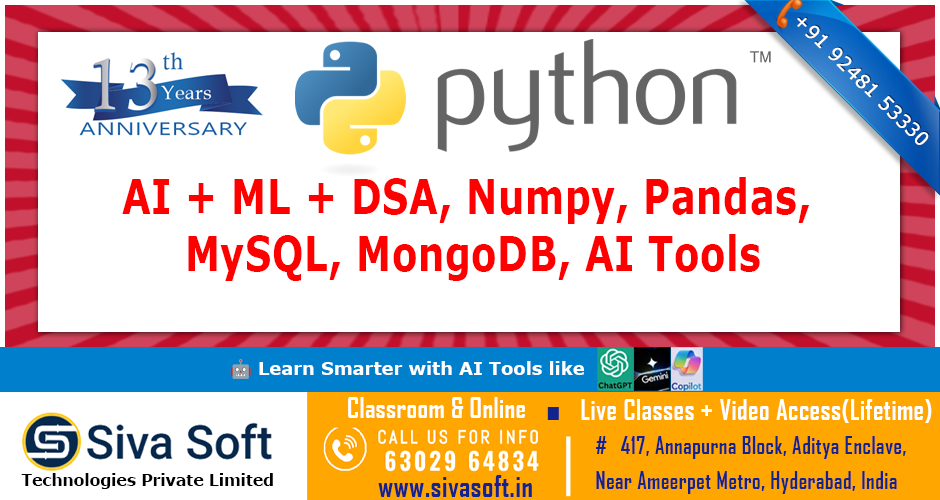Gain real-world skills from our trainers, who bring extensive experience from top multinational corporations. Their expertise ensures you receive industry-relevant training.
India's premier provider of classroom and online training in cutting-edge technologies.





🎓 Eligibility: Any Graduates / Career Gap
👨🏫 Trainer (120+ Batches): Mr. Siva(15+Yrs)
🌟 Offer: Valid only for 7 days
👨🏫 Group Training Fee: ₹20,000/-
➡️ Offer:
₹10,000/-
🧑💻 One-On-One Training Fee: ₹60,000/-
➡️ Offer:
₹30,000/-
📅 Duration: 3 Months Training
#''' ''' or
""" """
print()deltype()% Formatting,
format()
upper(), lower(),
split(), replace()
array Modulefrom ... import ... for selective imports__init__) and Destructors
(__del__)__str__,
__repr__, __len__, etc.)
super() to Call Parent Methodsiter() and next()
__iter__ and
__next__
datetime Modulestrftime(),
strptime())
math Module Functions: sqrt(),
factorial(), ceil(), floor()
random Modulesin(), cos(),
tan()
json.dumps())json.loads())json.dump(),
json.load())
re Module)^, $, .,
*, +, ?
pip install package_nameraise%) Formattingformat()) Formatting'r',
'w', 'a', 'rb',
'wb'
read(), readline(),
readlines()
write(),
writelines()
os.remove()os.path)with Statement for Auto File Closurepip install numpyimport numpy as nparray(), arange(),
linspace(), zeros(), ones(),
full(), eye()
shape, ndim,
size, dtype, itemsize
np.sin(),
np.cos(), np.exp(), etc.
sum(), min(),
max(), mean(), median(),
std(), var()
reshape()flatten(), ravel()transpose(), .Thstack(),
vstack(), split()
copy() vs view()rand(), randn(),
randint()
np.random.seed()dot(), matmul()np.linalg.solve()pip install pandasimport pandas as pdloc and
iloc
head(), tail(),
sample()
info(), describe(),
shape, columns
isnull(),
notnull()
unique(),
nunique(), value_counts()
fillna(), dropna(),
replace()
rename()astype()drop_duplicates()sort_values(), sort_index()apply(), map(),
applymap()
sum(), mean(),
count(), min(), max()
pivot_table()crosstab()concat()merge(), join()append()to_datetime()resample()rolling(),
expanding()
read_csv(),
to_csv()
read_excel(),
to_excel()
read_json(), to_json()
read_sql()CREATE, ALTER,
DROP, TRUNCATE, RENAME
INSERT, UPDATE,
DELETE
SELECT
GRANT, REVOKE
COMMIT, ROLLBACK,
SAVEPOINT, SET TRANSACTION
CREATE DATABASE.SHOW DATABASES;.USE.CREATE DATABASE studentdb;CREATE TABLE students (id INT AUTO_INCREMENT PRIMARY KEY, name VARCHAR(50), age INT);
ALTER TABLE students ADD email VARCHAR(100);
INSERT INTO.INSERT INTO students (name, age) VALUES ('Supriya', 22), ('Kiran', 24);
SELECT.SELECT id, name, age FROM students;=, <>, >,
<, BETWEEN, IN,
LIKE, IS NULL.
SELECT * FROM students WHERE age >= 20;
SELECT * FROM students ORDER BY name ASC;DELETE FROM.DELETE or
TRUNCATE.
DELETE FROM students WHERE id = 1;DROP TABLE students;UPDATE and
SET.
UPDATE students SET age = 25 WHERE name = 'Supriya';
SELECT * FROM students LIMIT 5;SELECT * FROM students LIMIT 5 OFFSET 10;
SELECT s.name, c.course_name FROM students s INNER JOIN courses c ON s.id = c.student_id;
SELECT COUNT(*) FROM students;GROUP BY.HAVING.SELECT age, COUNT(*) FROM students GROUP BY age HAVING COUNT(*) > 2;
SELECT name FROM students WHERE age > (SELECT AVG(age) FROM students);
GRANT SELECT ON school.* TO 'user'@'localhost';
START TRANSACTION; UPDATE students SET age=30 WHERE id=5; ROLLBACK;
CREATE VIEW.CREATE VIEW student_names AS SELECT name FROM students;
CREATE INDEX idx_name ON students(name);mysqldump.mysqldump -u root -p studentdb > backup.sql
use databasename.
show dbs.use studentDBdb.createCollection("students").
show collections.insertOne() and
insertMany().
db.students.insertOne({ name: "Supriya", age: 22 })
db.students.insertMany([{ name: "Kiran", age: 23 }, { name: "Ravi", age: 21 }])
find() and
findOne().
db.students.find(),
db.students.findOne({ name: "Supriya" })
$eq, $ne,
$gt, $lt, $gte,
$lte
$and, $or,
$not
db.students.find({ age: { $gt: 20 } })db.students.find().sort({ name: 1 })deleteOne() or
deleteMany().
db.students.deleteOne({ name: "Ravi" })db.students.drop()updateOne() or
updateMany().
$set, $inc, $unset
db.students.updateOne({ name: "Supriya" }, { $set: { age: 23 } })
limit() and skipping using
skip().
db.students.find().limit(5)aggregate().$match, $group,
$project, $sort, $limit
db.students.aggregate([ { $match: { age: { $gt: 20 } } }, { $group: { _id: "$course", total: { $sum: 1 } } } ])
db.students.createIndex({ name: 1 }){ name: "Supriya", courses: [{ courseName: "MERN" }, { courseName: "Python" }] }
db.createCollection("students", { validator: { $jsonSchema: { bsonType: "object", required: ["name", "age"], properties: { name: { bsonType: "string" }, age: { bsonType: "int", minimum: 18 } } } } })
db.createView().db.createView("adult_students", "students", [ { $match: { age: { $gte: 18 } } } ])
const session = client.startSession(); session.startTransaction(); db.students.updateOne(...); session.commitTransaction();
mongodump and mongorestore.mongodump --db studentDB --out /backup/studentDB
mongorestore /backup/studentDB
explain().
const Student = mongoose.model("Student", studentSchema); Student.find({ age: { $gte: 18 } })